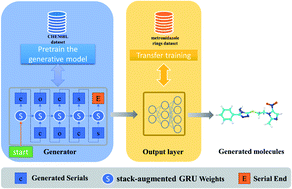Recurrent neural network (RNN) model accelerates the development of antibacterial metronidazole derivatives†
Abstract
Metronidazole is a specific drug against trichomonas and anaerobic bacteria, and is widely used in the clinic. However, extensive clinical application is often accompanied by extensive side effects, so it is still of great significance to develop metronidazole derivatives with a new skeleton. Compared with other traditional receptor-based drug design methods, the computational model based on a neural network has higher accuracy and reliability. In this work, a Recurrent Neural Network (RNN) model is applied to the discovery of metronidazole drugs with a new skeleton. Firstly, the generation model based on a Gated Recurrent Unit (GRU) is trained to generate an effective Simplified Molecular-Input Line-Entry System (SMILES) string library with high precision. Then, transfer learning is introduced to fine-tune the GRU model, and many molecules with structures similar to known active drugs are generated. After cluster analysis of the structures of the new compounds, 20 small molecular compounds with metronidazole structures of all different categories were selected, of which 19 may not belong to any published patents or applications. Through prediction and personal experience, the difficulty of synthesizing these 20 new structures was analyzed, and compound 0001 was chosen as our synthetic target, and a series of structures (8a–l) similar to compound 0001 were synthesized. Finally, the inhibitory activities of these compounds against bacteria E. coli, P. aeruginosa, B. subtilis and S. aureus were determined. The results showed that compound 8a–l had obvious inhibitory activity against these four bacteria, which proved the accuracy of our compound generation model.



 Please wait while we load your content...
Please wait while we load your content...